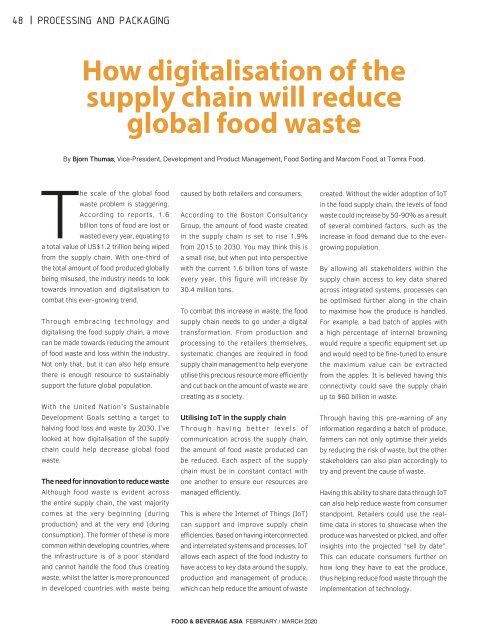Food & Beverage Asia February/March 2020
Food & Beverage Asia (FBA) is the leading source of food and beverage news in Asia since 2002. FBA delivers a comprehensive view of the food and beverage landscape, spanning across the latest health and nutrition trends and industry innovations in ingredients, recipe formulations, food science, sustainability, packaging, and automation, as well as advancements in agri and food-tech.
Food & Beverage Asia (FBA) is the leading source of food and beverage news in Asia since 2002. FBA delivers a comprehensive view of the food and beverage landscape, spanning across the latest health and nutrition trends and industry innovations in ingredients, recipe formulations, food science, sustainability, packaging, and automation, as well as advancements in agri and food-tech.
Create successful ePaper yourself
Turn your PDF publications into a flip-book with our unique Google optimized e-Paper software.
48<br />
PROCESSING AND PACKAGING<br />
How digitalisation of the<br />
supply chain will reduce<br />
global food waste<br />
By Bjorn Thumas, Vice-President, Development and Product Management, <strong>Food</strong> Sorting and Marcom <strong>Food</strong>, at Tomra <strong>Food</strong>.<br />
The scale of the global food<br />
waste problem is staggering.<br />
According to reports, 1.6<br />
billion tons of food are lost or<br />
wasted every year, equating to<br />
a total value of US$1.2 trillion being wiped<br />
from the supply chain. With one-third of<br />
the total amount of food produced globally<br />
being misused, the industry needs to look<br />
towards innovation and digitalisation to<br />
combat this ever-growing trend.<br />
Through embracing technology and<br />
digitalising the food supply chain, a move<br />
can be made towards reducing the amount<br />
of food waste and loss within the industry.<br />
Not only that, but it can also help ensure<br />
there is enough resource to sustainably<br />
support the future global population.<br />
With the United Nation’s Sustainable<br />
Development Goals setting a target to<br />
halving food loss and waste by 2030, I’ve<br />
looked at how digitalisation of the supply<br />
chain could help decrease global food<br />
waste.<br />
The need for innovation to reduce waste<br />
Although food waste is evident across<br />
the entire supply chain, the vast majority<br />
comes at the very beginning (during<br />
production) and at the very end (during<br />
consumption). The former of these is more<br />
common within developing countries, where<br />
the infrastructure is of a poor standard<br />
and cannot handle the food thus creating<br />
waste, whilst the latter is more pronounced<br />
in developed countries with waste being<br />
caused by both retailers and consumers.<br />
According to the Boston Consultancy<br />
Group, the amount of food waste created<br />
in the supply chain is set to rise 1.9%<br />
from 2015 to 2030. You may think this is<br />
a small rise, but when put into perspective<br />
with the current 1.6 billion tons of waste<br />
every year, this figure will increase by<br />
30.4 million tons.<br />
To combat this increase in waste, the food<br />
supply chain needs to go under a digital<br />
transformation. From production and<br />
processing to the retailers themselves,<br />
systematic changes are required in food<br />
supply chain management to help everyone<br />
utilise this precious resource more efficiently<br />
and cut back on the amount of waste we are<br />
creating as a society.<br />
Utilising IoT in the supply chain<br />
Through having better levels of<br />
communication across the supply chain,<br />
the amount of food waste produced can<br />
be reduced. Each aspect of the supply<br />
chain must be in constant contact with<br />
one another to ensure our resources are<br />
managed efficiently.<br />
This is where the Internet of Things (IoT)<br />
can support and improve supply chain<br />
efficiencies. Based on having interconnected<br />
and interrelated systems and processes, IoT<br />
allows each aspect of the food industry to<br />
have access to key data around the supply,<br />
production and management of produce,<br />
which can help reduce the amount of waste<br />
created. Without the wider adoption of IoT<br />
in the food supply chain, the levels of food<br />
waste could increase by 50-90% as a result<br />
of several combined factors, such as the<br />
increase in food demand due to the evergrowing<br />
population.<br />
By allowing all stakeholders within the<br />
supply chain access to key data shared<br />
across integrated systems, processes can<br />
be optimised further along in the chain<br />
to maximise how the produce is handled.<br />
For example, a bad batch of apples with<br />
a high percentage of internal browning<br />
would require a specific equipment set up<br />
and would need to be fine-tuned to ensure<br />
the maximum value can be extracted<br />
from the apples. It is believed having this<br />
connectivity could save the supply chain<br />
up to $60 billion in waste.<br />
Through having this pre-warning of any<br />
information regarding a batch of produce,<br />
farmers can not only optimise their yields<br />
by reducing the risk of waste, but the other<br />
stakeholders can also plan accordingly to<br />
try and prevent the cause of waste.<br />
Having this ability to share data through IoT<br />
can also help reduce waste from consumer<br />
standpoint. Retailers could use the realtime<br />
data in stores to showcase when the<br />
produce was harvested or picked, and offer<br />
insights into the projected “sell by date”.<br />
This can educate consumers further on<br />
how long they have to eat the produce,<br />
thus helping reduce food waste through the<br />
implementation of technology.<br />
FOOD & BEVERAGE ASIA FEBRUARY / MARCH <strong>2020</strong>


















